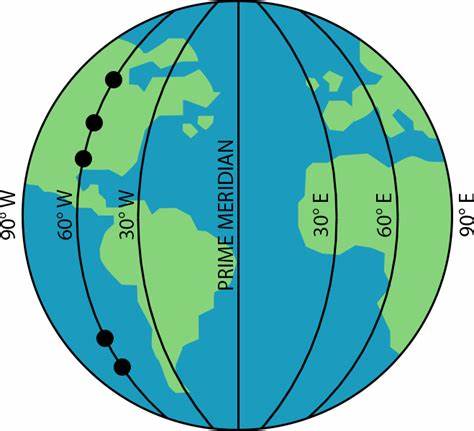longitudine (i)
longitude (s)
Längengrad(e) (G)
longitude (p)
longitude (e)
The prime meridian at The Royal observatory, greenwich, england
So, go back to the vision of an orange with horizontal stripes. If you knew on which stripe you were, you’d know how far north or south of the equator you were. But what about east and west? Well, that is where longitude comes in. If you picture lines going vertically up and down the orange, like so (or comme ca for you Francophiles),

those lines measure longitude. Just as the equator is zero degrees latitude, the Prime Meridian is zero degrees longitude and locations are either east or west of the Prime Meridian. The Prime Meridian is located at the Royal Observatory in Greenwich, England, east of London. Why there? Click the button to find out.
As with latitude, positions of longitude are given in degrees, minutes and seconds with the latitude position first. Just as with latitude, degrees can be further divided into 60 minutes and then into 60 seconds. Unlike latitude, where there are 69 miles between each degree, the distance between each degree of longitude varies greatly depending upon location. A degree of longitude is approximately 69 miles at the equator and the distance shrinks until the lines meet at the North or South pole. They are farthest apart at the equator and converge at the poles.
Since a point’s longitude indicates how far east or west a particular location is from the Prime Meridian, a longitude position was traditionally written as XX degrees, XX minutes and XX seconds East or West. It can also be written in decimal degrees. If so, locations in the Western Hemisphere are written as a negative. Click here for information on latitude. With a latitude and longitude position, you can determine exactly where you are in the world. Amazingly, unlike back in the day when determining your exact position was very difficult and took a great deal of time, now most mobile phones will give its user a very specific and accurate lat/long position with the press of a button.
If you take a look at the picture and think about where the equator is, the spot where the equator and the Prime Meridian intersect is in the middle of the ocean, not on land, and is o degrees latitude, o degrees longitude or as some sarcastically refer to it, Null Island. Conversely, since the Royal Observatory in Greenwich is well north of the equator, its lat/long position is 51 degrees 28 minutes, and 38 seconds N, 0 degrees longitude.
Not only is the Royal Observatory the location of the Prime Meridian but it is also the center of time in the world. The time in other parts of the world is often converted to Greenwich Mean Time. The Prime or Greenwich Meridian was decided upon at the International Meridian Conference, held in Washington, D.C. in October 1884. With the advent of trains and faster ships, there was a need for a common standard of time and for a common zero of longitude. You couldn’t have trains colliding because one train was on a track at the wrong time but what its operators thought was the right time. (Thank goodness, this was figured out before airplanes come on the scene.)
In some ways, the choice of Greenwich was a fait accompli (ironically, French for something already done) as Greenwich had already been chosen by the United States as the basis for its time zones and most of the ships plying the ocean used charts or maps with a location of Greenwich as the Prime Meridian. Twenty-five nations attended the 1884 conference and Greenwich won in a landslide by a vote of 22 to 1 with two abstentions (France and Brazil). France wanted mean time to run through France, east of Greenwich, roughly from Dunkirk to the Pyrenees, and stuck with that standard for almost 30 years after the conference.
However, the French had a little satisfaction in 1984, when a new true prime meridian was agreed to by all the nations of the world, based on satellite data and other measurements unavailable in 1884 at the time of the original conference. Known as the International Reference Meridian, it passes 102.5 meters or more than 330 feet east of the original Prime Meridian of the World, a little closer to France than the original line. So, the Royal Observatory and the original Prime Meridian are now actually west of the International Reference Meridian.